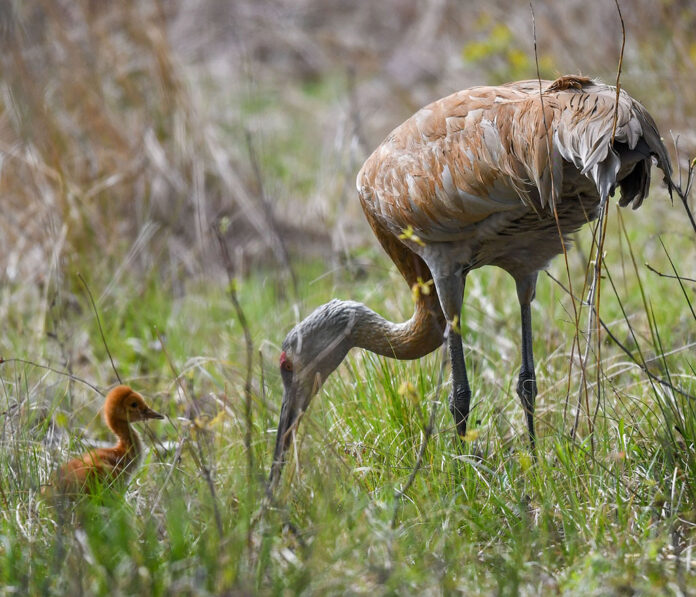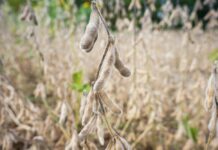
PORT CLINTON, Ohio — Dick Lano and Todd Winke are extremely pleased with the new tile installed in their farm fields in Ottawa County as part of the Little Portage Project. Yet they seem just as pleased — and proud — that they are playing a part in what could result in the Little Portage Wildlife Area becoming more popular with migratory birds, as well as other winged wildlife that use marshes and wetlands for nesting and rearing their young.
“We expect Little Portage to become a birding hotspot,” said Russ Terry, senior regional biologist for Ducks Unlimited, who directed the project. “But it will also benefit other kinds of wildlife. And people, with more recreational opportunities.”
The area will once again be a destination for waterfowl hunters, he said. New levees resulted in a hiking trail that surrounds the 357-acre wildlife area. The levees also provide fishing access to the Little Portage and Portage rivers.
The Little Portage Project was funded by a $2.9 million grant from H2Ohio, $1.2 million in federal funds from the Pittman-Robertson Wildlife Restoration Act, plus grants from the National Oceanic and Atmospheric Administration and Ducks Unlimited. Part of the money was used to install new drain tile on both Lano’s and Winke’s farms. The tiling was engineered so that surface and subsurface water from more than 400 acres would flow to a pumping system, which sends it into Seaman’s Ditch. The ditch takes the water under the road and into a collection basin in the wildlife area.
That means nutrients from ag runoff — either floating in the water or attached to sediment — will now go to the wetlands, where they will nourish plants and trees that take them up through their roots. That’s why the wetlands are known as nature’s kidneys; the plants filter bad stuff out of the water and use it for good.
Winke said some programs pay farmers to convert farmland to wetlands, “but it seems a shame to use land where their ancestors worked so hard to make a living and to produce food for the world.”
“What’s unique about this program is that we benefit by the improvement of our land, while it also improves the existing wetlands,” he said. “It’s a win-win.”
Runoff

The original owner of Lano’s farm was awarded it for serving in the War of 1812. It was purchased in 1860 by his mother’s family, the Hopfingers, “so in 200 years, the farm has had only two owners,” he said. “It being in the family so long means a lot to me.”
He grew up on the farm, working 70 acres of cropland to pay his way through college. After graduation, he married Jami Schwind and began to work for her family’s business, the JVS Garage Door Company in Port Clinton. He now owns that company.
Not surprisingly, tending crops became too much for him in the mid-1980s. That’s when he became friends with Todd Winke, who had purchased the farm next door. Winke now takes care of 60 acres of Lano’s farm, planting it in corn, wheat and soybeans. He is hoping to add alfalfa hay to the rotation as the new drainage system improves the soil health.
“He’s a great steward of the land and uses a lot of the new, conservation-type farming methods,” Lano said.
“Our farm is unique because it has a mile-long river frontage,” he said, referring to the Little Portage River on the west side of his property. It runs north into the Portage River, which flows east into Lake Erie. To supplement his income, his grandfather made duck marshes along the Little Portage, and hunters paid to use them.
Like all the others in the former Black Swamp, Lano’s and Winke’s farms are flat and full of clay. There used to be tile — also clay — “but who knows when it was installed? It deteriorated from age,” Lano said.
His farm and others had dikes and pump stations so that when the fields flooded, they could pump the excess water into the Little Portage River. But severe flooding in 1969 and 1970 “wiped out all the dikes, including the one in our hunting marsh,” he said.
Winke grows wheat, corn, soybeans and alfalfa on the 350-acre farm that adjoins Lano’s. He was one of the first in the area to do no-till and become involved with the Conservation Reserve Program, applying fertilizer at variable rates depending on soil samples.
But even with conservation measures, agricultural runoff was going into the Little Portage River, then into Lake Erie, with no filtering in between. There, nutrients like phosphorus and nitrogen cause algal blooms that are toxic to humans, fish and animals. One of these blooms caused the city of Toledo to issue a “Do not drink” order in 2014.
In an effort to reduce these toxic blooms, Gov. Mike DeWine launched the H2Ohio program in 2019, partnering with the Ohio Department of Agriculture, Ohio Department of Natural Resources and other agencies.
Restoration benefits
Little Portage is classified as a wetland restoration project. As levees and pumps aged and ceased to function, the wetlands suffered. The project removed a mile of unnecessary levees and replaced 16 pumping stations with four water-control stations engineered by Ducks Unlimited, Terry said.
That means water collected from Seaman’s Ditch can now be pumped into four different wetland areas, which can be managed independently. Water can also be pumped out in case of a big rainstorm or melting snow, or to do a “drawdown” to make the marsh plants grow. Patrick Baranowski, wildlife area supervisor for the Division of Wildlife, worked closely with Terry on the Little Portage Project. He will make sure the water is at the correct depths for different times of the year.
This will help revive the wetland plants and aquatic wildlife that are so needed by waterfowl, shorebirds and migrating birds, like the neotropical ones that draw 90,000 visitors a year to northwest Ohio during the Biggest Week in American Birding, held May 9 to May 18.
While some of those birds come from the southern United States, others may journey from Central or South America. Even though it is the shortest route across the water, crossing the western basin of Lake Erie is intimidating. They need a place to rest and refuel, both going north in the spring and flying back south in the fall.
Ducks, for instance, take cover in plants that emerge from the water in order to rest in safety. They also use these plants for food, eating the seeds or tubers, and in some cases the plants themselves. Other types of birds, plus mammals such as beavers, muskrats and river otters, also use these plants for food.
“We want to promote a diversity of native wetland plants like smartweed, millet, bulrush, arrowhead and cattails, which provide those seeds and tubers, attract aquatic insects and provide cover,” Terry said.
Surprisingly, this will not involve planting new vegetation. The seeds are already in the soil and some can remain viable for 100 years or longer, he said. What they need to grow are the right environmental conditions, which he and others hope the machinery of the Little Portage Project will provide.
They also hope the restored wetlands will attract more birds that can use them for nesting and raising their young through the summer. Pied-billed grebes like to build floating nests in marsh vegetation away from shore, while blue-winged teal often choose the dense vegetation on dikes or fields bordering the water. Both begin nesting in April.
Sandhill cranes, an endangered species in Ohio, require large tracts of wetlands or shallow marshes for nesting. The great egret, symbol of the Audubon Society for its recovery after being plundered for its white plumes, wades belly-deep in wetlands searching for fish, crayfish, amphibians and water bugs. They like to nest in trees or bushes at the water’s edge.
Bald eagles share the egrets’ desire for fish, and they love to nest in the marshes of the Western Basin. According to the ODNR, Ottawa County has the highest number of nesting pairs in the state, with about 100 at the last count. More are expected to move into the Little Portage Wildlife Area as the wetlands improve.










This is absurd, they are diverting agricultural runoff, wastewater, into a wetland and calling that remediation? Unbelievable